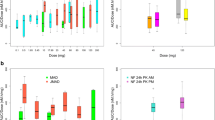Abstract
Purpose
Crenigacestat (LY3039478) is a Notch inhibitor currently being investigated in advanced cancer patients. Conducting clinical pharmacology studies in healthy subjects avoids nonbeneficial drug exposures in cancer patients and mitigates confounding effects of disease state and concomitant medications.
Methods
Three studies were conducted in healthy subjects, assessing safety, pharmacokinetics, effect on QT interval, and relative and absolute bioavailability of crenigacestat. Crenigacestat was administered as single 25, 50, or 75 mg oral doses or as an intravenous dose of 350 µg 13C15N2H-crenigacestat. Electrocardiogram measurements, and plasma and urine samples were collected up to 48 h postdose, and safety assessments were conducted up to 14 days postdose.
Results and conclusions
Exposures were dose proportional in the 25 to 75 mg dose range and mean elimination half-life was approximately 5–6 h. The exposure achieved from the new formulated capsule was approximately 30% and 20% higher for area under the plasma concentration time curve from time zero to infinity [AUC(0–∞)] and maximum plasma concentration (Cmax), respectively, compared to the reference drug in capsule formulation. The geometric least-squares mean [90% confidence interval (CI)] absolute bioavailability of crenigacestat was 0.572 (0.532, 0.615). The regression slope (90% CI) of placebo-adjusted QTcF against crenigacestat plasma concentration was − 0.001 (− 0.006, 0.003), suggesting no significant linear association. Thirty-nine subjects completed the studies and the majority of adverse events were mild. Single oral doses of 25 to 75 mg crenigacestat and an IV dose of 350 µg 13C15N2H-crenigacestat were well tolerated in healthy subjects.


Similar content being viewed by others
References
ArtavanisTsakonas S, Rand MD, Lake RJ (1999) Notch signaling: cell fate control and signal integration in development. Science 284:770776
Bender M, Gao H, Capen A, Clay J, Hipskind P, Reel J, Zamek-Gliszczynski M, Manro J, Benhadji K, Patel B (2013) Abstract 1131: novel inhibitor of notch signaling for the treatment of cancer. Proc: AACR 104th Annual Meeting 73(8):1131
Massard C, Azaro A, Soria JC, Lassen U, Le Tourneau C, Sarker D, Smith C, Ohnmacht U, Oakley G, Patel B, Yuen E, Benhadji K, Rodon J (2018) First-in-human study of LY3039478, an Oral Notch signaling inhibitor in advanced or metastatic cancer. Ann Onc 29(9):1911–1917
Yuen E, Patel B, Smith C, Posada M, Bell R, Ohnmacht U, Massard C, Rodon J, Benhadji K (2016) Abstract CT048: population pharmacokinetics and pharmacodynamics for an oral Notch inhibitor, LY3039478, in the first-in-man study. Cancer Res 76(14):CT048
International Conference on Harmonization (2015) E14 Implementation Working Group—ICH E14 Guideline: The Clinical Evaluation of QT/QTc Interval Prolongation and Proarrhythmic Potential for Non-Antiarrhythmic Drugs—Questions & Answers (R3). http://www.ich.org/fileadmin/Public_Web_Site/ICH_Products/Guidelines/Efficacy/E14/E14_Q_As_R3__Step4.pdf. Accessed 1 Aug 2017
Darpo B, Sarapa N, Garnett C, Benson C, Dota C, Ferber G, Jarugula V, Johannsen L, Keirns J, Krudys K, Ortemann-Renon C, Riley S, Rogers-Subramaniam D, Stockbridge N (2014) The IQCSRC prospective clinical Phase 1 study: “Can early QT assessment using exposure response analysis replace the thorough QT study?”. Ann Noninvasive Electrocardiol 19(1):70–81
Bloomfield B (2015) Incorporating exposure-response modeling into the assessment of QTc interval: a potential alternative to the thorough QT study. Clin Pharmacol Ther 97(5):444–446
Therapeutic Goods Administration (2015) Guidance 15—Biopharmaceutic studies version 1.1. https://www.tga.gov.au/sites/default/files/guidance-15-biopharmaceutic-studies.pdf. Accessed 1 Aug 2017
Jiang H, Zeng J, Li W, Bifano M, Gu H, Titsch C, Easter J, Burrell R, Kandoussi H, Aubry AF, Arnold ME (2012) Practical and efficient strategy for evaluating oral absolute bioavailability with an intravenous microdose of a stable isotopically-labeled drug using a selected reaction monitoring mass spectrometry assay. Anal Chem 84(22):10031–10037
Lachno DR, Emerson JK, Vanderstichele H, Gonzales C, Martenyi F, Konrad RJ, Talbot JA, Lowe SL, Oefinger PE, Dean RA (2012) Validation of a multiplex assay for simultaneous quantification of amyloid-β peptide species in human plasma with utility for measurements in studies of Alzheimer’s disease therapeutics. J Alzheimer’s Disease 32:905–918
Smith BP, Vandenhende FR, DeSante KA, Farid NA, Welch PA, Callaghan JT, Forgue ST (2000) Confidence interval criteria for assessment of dose proportionality. Pharm Res 17(10):1278–1283
Food and Drug Administration (2005) Guidance for industry E14: clinical evaluation of QT/QTc interval prolongation and proarrhythmic potential for non-antiarrhythmic drugs. https://www.fda.gov/downloads/Drugs/GuidanceComplianceRegulatoryInformation/Guidances/ucm073153.pdf. Accessed 9 Nov 2018
Milano J, McKay J, Dagenais C, Foster-Brown L, Pognan F, Gadient R, Jacobs RT, Zacco A, Greenberg B, Ciaccio PJ (2004) Modulation of notch processing by gamma-secretase inhibitors causes intestinal goblet cell metaplasia and induction of genes known to specify gut secretory lineage differentiation. Toxicol Sci 82(1):341–358
Funding
This study was funded by Eli Lilly and Company.
Author information
Authors and Affiliations
Corresponding author
Ethics declarations
Conflict of interest
All authors are employees of Eli Lilly and Company.
Ethical approval
All procedures performed in studies involving human participants were in accordance with the ethical standards of the institutional and/or national research committee and with the 1964 Helsinki declaration and its later amendments or comparable ethical standards.
Informed consent
Informed consent was obtained from all individual participants included in the study.
Electronic supplementary material
Below is the link to the electronic supplementary material.
Rights and permissions
About this article
Cite this article
Yuen, E., Posada, M., Smith, C. et al. Evaluation of the effects of an oral notch inhibitor, crenigacestat (LY3039478), on QT interval, and bioavailability studies conducted in healthy subjects. Cancer Chemother Pharmacol 83, 483–492 (2019). https://doi.org/10.1007/s00280-018-3750-1
Received:
Accepted:
Published:
Issue Date:
DOI: https://doi.org/10.1007/s00280-018-3750-1




